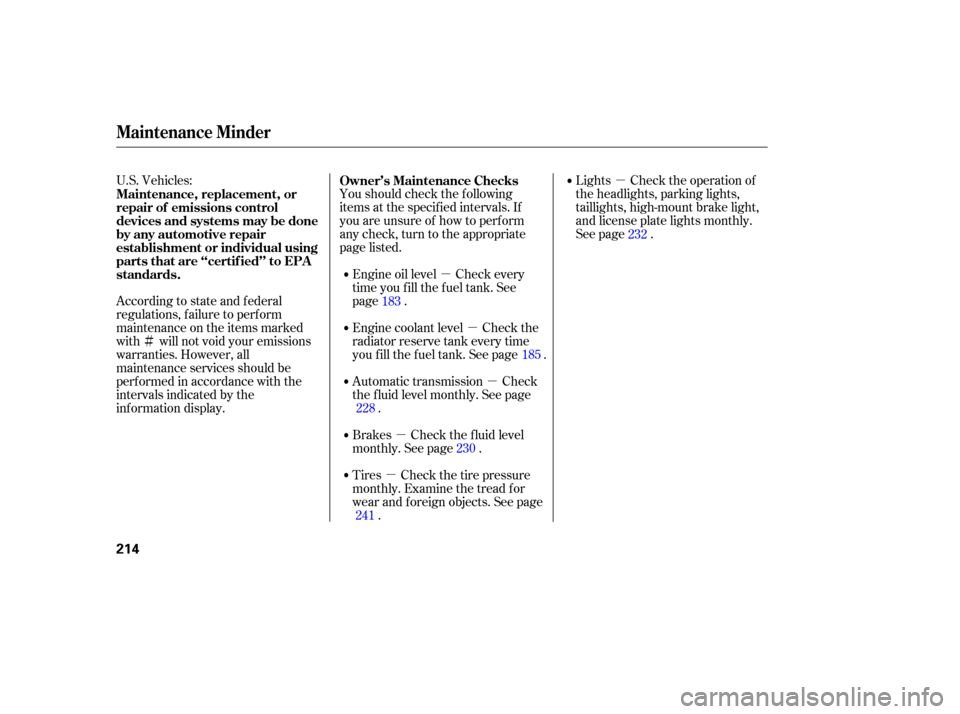Page 207 of 307

Check the brakes after driving
through deep water. Apply the
brakes moderately to see if they f eel
normal. If not, apply them gently and
f requently until they do. Be extra
cautious in your driving.
The hydraulic system that operates
the brakes has two separate circuits.
Each circuit works diagonally across
the vehicle (the lef t-f ront brake is
connected with the right-rear brake,
etc.). If one circuit should develop a
problem, you will still have braking
at two wheels.
Resting your f oot on the pedal keeps
the brakes applied lightly, builds up
heat, and reduces their ef f ectiveness.
It also keeps your brake lights on all
the time, conf using drivers behind
you.
Constant application of the brakes
when going down a long hill builds
up heat and reduces their ef f ective-
ness. Use the engine to assist the
brakes by taking your f oot of f the
accelerator and downshif ting to a
lower gear. Your vehicle is equipped with f ront
disc brakes. The brakes on the rear
wheels may be disc or drum,
depending on the model. A power
assist helps reduce the ef f ort needed
on the brake pedal. The ABS helps
you retain steering control when
braking very hard. If the brake pads need replacing, you
will hear a distinctive, metallic
screeching sound when you apply
the brake pedal. If you do not have
the brake pads replaced, they will
screech all the time. It is normal f or
the brakes to occasionally squeal or
squeak when you apply them.
Braking System Design Brake Wear Indicators
Braking System
Driving
203
�����—�����—�����y�
�����������
�y���
�(�+���������y���������y
Page 211 of 307

This section explains why it is
important to keep your vehicle well
maintained and how to f ollow basic
maintenance saf ety precautions.
If you have the skills and tools to
perf orm more complex maintenance
tasks on your vehicle, you may want
to purchase the service manual. See
page f or inf ormation on how to
obtain a copy, or see your dealer. This section also includes
instructions on how to read the
maintenance minder messages in the
inf ormation display, a maintenance
record, and instructions f or simple
maintenance tasks you may want to
take care of yourself .......................
Maintenance Saf ety .208
....................
Maintenance Minder .209
....................
Maintenance Record .216
..............................
Fluid Locations .218
........................
Adding Engine Oil .220
.......
Recommended Engine Oil .220
..............................
Synthetic Oil .221
................
Engine Oil Additives .221
.........
Changing the Oil and Filter .222
..............................
Engine Coolant .224
....................
Windshield Washers .227
....
Automatic Transmission Fluid .228
........
Manual Transmission Fluid .229
................
Brake and Clutch Fluid .230
....................
Power Steering Fluid .231
.............................................
Lights .232
................
Cleaning the Seat Belts .237
.....................................
Floor Mats .238
..................
Dust and Pollen Filter .239
.................................
Wiper Blades .239
...............................................
Tires .241
...................
Checking the Battery .248
.............................
Vehicle Storage .250
291
Maintenance
Maint enance
207
�����—�����—�����y�
���������
���y���
�(�+���������y�����
���y
Page 218 of 307

�µ
�µ
�µ
�µ
�µ
�µ
�Ì
U.S. Vehicles:
Youshouldcheckthefollowing
items at the specif ied intervals. If
you are unsure of how to perf orm
any check, turn to the appropriate
page listed. Lights Check the operation of
the headlights, parking lights,
taillights, high-mount brake light,
and license plate lights monthly.
See page .
Engine coolant level Check the
radiator reserve tank every time
you f ill the f uel tank. See page . Engine oil level Check every
time you fill the fuel tank. See
page .
Automatic transmission Check
the f luid level monthly. See page .
Brakes Check the f luid level
monthly. See page .
Tires Check the tire pressure
monthly. Examine the tread f or
wear and foreign objects. See page .
According to state and federal
regulations, f ailure to perf orm
maintenance on the items marked
with will not void your emissions
warranties. However, all
maintenance services should be
perf ormed in accordance with the
intervals indicated by the
inf ormation display.
183
185
228 230
241 232
Maintenance, replacement, or
repair of emissions control
devices and systems may be done
by any automotive repair
establishment or individual using
parts that are ‘‘certif ied’’ to EPA
standards. Owner’s Maintenance Checks
Maintenance Minder
214
�����—�����—�����y�
�������������y���
�(�+���������y�����
���y
Page 222 of 307
Fluid Locations
DX, Canadian DX-G, L X, and EX models
218
WASHER FLUID
(Blue cap)POWER STEERING
FLUID (Red cap)
RADIATOR CAP
ENGINE OIL
FILL CAP
ENGINE OIL DIPSTICK
(Orange handle) BRAKE FLUID
(Black cap)
CLUTCH FLUID
(Manual
transmission only)
(Light gray cap)AUTOMATIC
TRANSMISSION
FLUID DIPSTICK
(Yellow loop)ENGINE COOLANT
RESERVOIR
�����—�����—�����y�
�������������y���
�(�+���������y�������
�y
Page 223 of 307
Fluid Locations
Si model
Maint enance
219
RADIATOR CAP
ENGINE OIL
FILL CAP
WASHER FLUID
(Blue cap)
ENGINE COOLANT
RESERVOIR
BRAKE FLUID
(Black cap)
ENGINE OIL DIPSTICK
(Orange handle)
CLUTCH FLUID
(Light gray cap)
�����—�����—�����y�
�������������y���
�(�+���������y���������y
Page 236 of 307
Theheadlightswereproperlyaimed
when your vehicle was new. If you
regularly carry heavy items in the
trunk, readjustment may be required.
Adjustment should be done by your
dealer or other qualif ied mechanic.Your vehicle has halogen headlight
bulbs. When replacing a bulb, handle
it by its base, and protect the glass
f rom contact with your skin or hard
objects. If you touch the glass, clean
it with denatured alcohol and a clean
cloth.
Open the hood.
To change a bulb on the driver’s
side, remove the coolant tube f rom
the two clips, then remove the
reserve tank f rom its holder by
pulling it straight up.
1.
Lights
Headlight A iming
Replacing a Headlight BulbHigh Beam Headlight
232
COOLANT
TUBE
CLIP
Halogen headlight bulbs get very hot
when lit. Oil, perspiration, or a scratch
on the glass can cause the bulb to
overheat and shatter.
�����—�����—�����y�
�������������y���
�(�+���������y���������y
Page 237 of 307
Push the electrical connector back
onto the bulb. Make sure it is on
all the way.
Turn on the headlights to test the
new bulb. Insert the new bulb into the hole,
and turn it one-quarter turn clock-
wise to lock it in place.
Remove the bulb by turning it
about one-quarter turn
counterclockwise. Remove the electrical connector
f rom the bulb by pushing on the
tab to unlock it, then slide the
connector of f the bulb. (Driver’s side)
Put the tube back in the clips and
install the reserve tank back in
place, making sure its bottom tab
is in the holder.
2.
3. 4.
5.
6.
7.
CONT INUED
Lights
Maint enance
233
TAB
BULB
CONNECTOR
HOLDER
�����—�����—�����y�
�������������y���
�(�+���������y���������y
Page 238 of 307
To change the driver’s side bulb,
start the engine, turn the steering
wheel all the way to the right, and
turn of f the engine. To change the
passenger’s side bulb, turn the
steering wheel to the lef t. Remove the electrical connectorf rom the bulb by pushing on the
tab to unlock it, then slide the
connector of f the bulb.Remove the bulb f rom the
headlight assembly by turning it
one-quarter turn counterclockwise.
Insert the new bulb into the hole,
and turn it one-quarter turn clock-
wise to lock it in place.
Push the electrical connector back
onto the bulb. Make sure it is on
all the way.
Turn on the headlights to test the
new bulb.
Use a Phillips head screwdriver to
remove the screw from the inner
f ender, and pull the inner f ender
cover back. Reinstall the inner f ender cover.
Then reinstall the screw and
tighten it securely.
2.
1.
3.4.
5.
6.
7.
8.
Lights
L ow Beam Headlight
234
SCREW
�����—�����—�����y�
�������������y���
�(�+���������y���������y